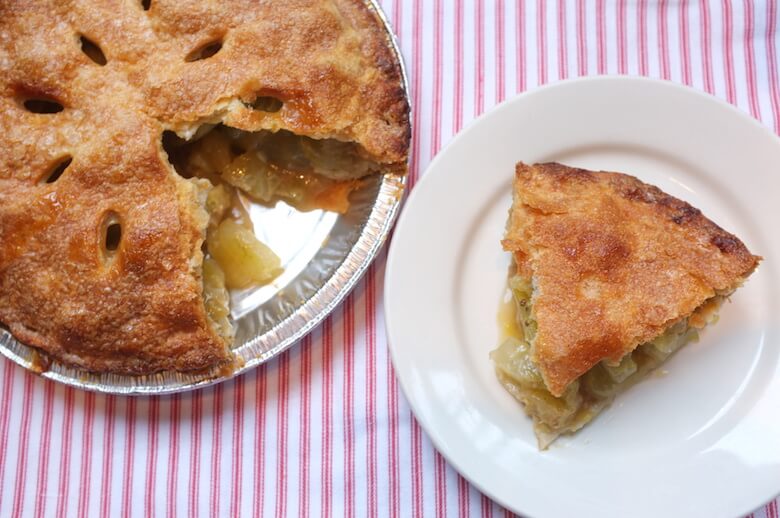
The cheapest tomatoes you’ll find at the farmers market are probably green. I’m not talking about ripe heirlooms like Lucky Tigers or Aunt Ruby’s German Greens. Instead, I’m referring to the unripe kind, which can be pretty much any variety. These are firm (tough, even), and lack the flavor of their more mature counterparts.
Green tomatoes might not be as BLT-ready as some fully developed one-pounders, but with a little more time and effort, they can still be delicious. Frying them might be the first recipe that comes to mind, and for good reason—most fried things are delicious. Pickles are another great option since a green tomato’s texture can lend a satisfying crunch. But perhaps a less considered option is a sweet pie.
Bubby’s makes a great one, in fact, and I recently got my hands on their recipe. The most surprising thing about this dessert is how much it tastes like apple pie. Green tomatoes have a similar texture and lack any strong vegetal flavor. They soak up the spices well, and if anything, I’d subtract at least a half-cup of sugar from the filling. My palate leans a bit toward savory flavors, though, so try it out, live your life and bake as you wish.
—
Bubby’s Green Tomato Pie
Courtesy of Ron Silver
Makes 1 pie

Ingredients
Pastry for all-butter double-crust pie (9 inches), recipe below
1½ cups sugar
5 tablespoons all-purpose flour
1 teaspoon ground cinnamon
¼ teaspoon ground clove
Pinch salt
3 cups thinly sliced green tomatoes (about 4 to 5 medium ones)
1 tablespoon cider vinegar
1 tablespoon butter
For the all-butter pastry pie dough:
Makes 8- to 10-inch double crust
4 to 5 tablespoons ice cold water
1½ cups all-purpose flour
¼ teaspoon salt
8 tablespoons cold, unsalted butter
For the pie pastry:
Measure out the water for the crust (with a bit extra in case you need a touch more) and then add ice cubes. Chill it in the freezer.
Measure out flour (unsifted) by leveling off dry measuring cups, and add the flour to large bowl. Add the salt to the flour and stir.
Take cold butter, measure out the amount you need, and then coat the cold, solid stick with the flour in the bowl. Using a dough scraper or a long butcher knife, cut the butter lengthwise in half, and then lengthwise in quarters, coating each newly cut side with flour as you go. Dice the butter into ¼-inch cubes. Break up any pieces that stick together and toss them all to coat them with flour. (If it is a warm day, chill this mixture briefly in the freezer before continuing.)
Using a pastry cutter, press the blades through the mixture, bearing down repeatedly like you would to mash potatoes. Repeat this gesture until the largest pieces of butter are the size of shelling peas and the smallest are the size of lentils (none smaller). Do not get over-enthusiastic here: This size range makes for excellent flakiness. Rechill if necessary.
Next, when adding the water, begin with a fully chilled flour and butter mixture and ice cold water. Be judicious, even stingy, with the water. Do not add all the water at once; it must be dispersed into the mixture incrementally. Add water two or three tablespoons at first, quickly tossing the mixture with your hands after each addition with light upward motion to distribute the water evenly throughout. Work the dough as little as possible.
Continue adding little bits of water at a time. When there are no floury bits anymore—just little comet-like cobbles that don’t quite cohere—slow down and sprinkle or flick water in at this point. One drop can make the difference and bring it all together. The balance can shift quickly from crumbly to wet. The pastry should be just a little bit tacky when you touch it.
To test the dough for consistency, lightly pat together some dough the size of a tennis ball. If the ball crumbles apart or has lots of dry-looking cracks in it, the dough is still too dry; let it break apart. Add a drop or two of water to the outside of the ball and work it just a little. If it holds and feels firm and supple, mop up any remaining crumbs with the ball—if they pick up easily, the dough is probably wet enough. If they fall back into the bowl, you might need a touch more water to pull the dough together.
Dough can feel like it’s holding together because the butter is melting. If at any point the dough ceases to feel cool to the touch or the butter pieces feel melty, soft and/or warm, put the whole mixture in the freezer until it’s cooled again—about 10 minutes.
Divide the dough into slightly uneven halves and shape each half into a ball—the larger of which will be for the bottom crust, the smaller ball for the top. Cover each ball tightly with plastic wrap and refrigerate it for at least half an hour to relax and slow the gluten development and re-chill the fat. In practical terms, this cold rest makes the dough easier to roll out.
For the pie assembly:
Preheat oven to 350° F.
In a bowl, combine the sugar, flour, cinnamon, clove and salt.
Add tomatoes and vinegar; toss to coat.
Roll out the larger of your two balls of dough—your bottom crust—to about 10 inches. Place it in the 9-inch pie plate. Add filling, dotting the top with butter.
Roll out remaining pastry ball; make a lattice crust. Trim, seal and flute edges.
Bake at 350° for 1 hour or until tomatoes are tender.
Photos courtesy of Bubby’s.



